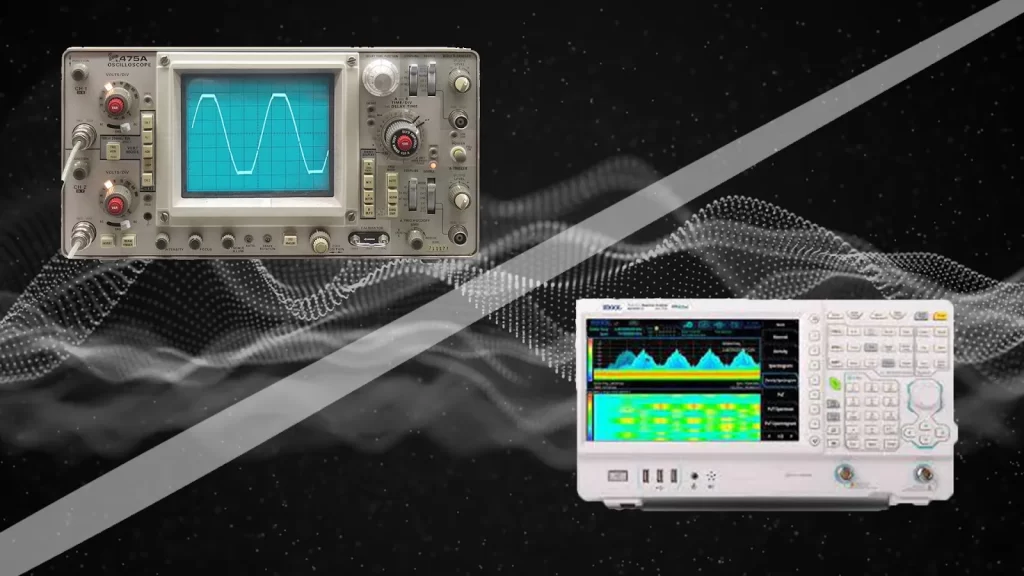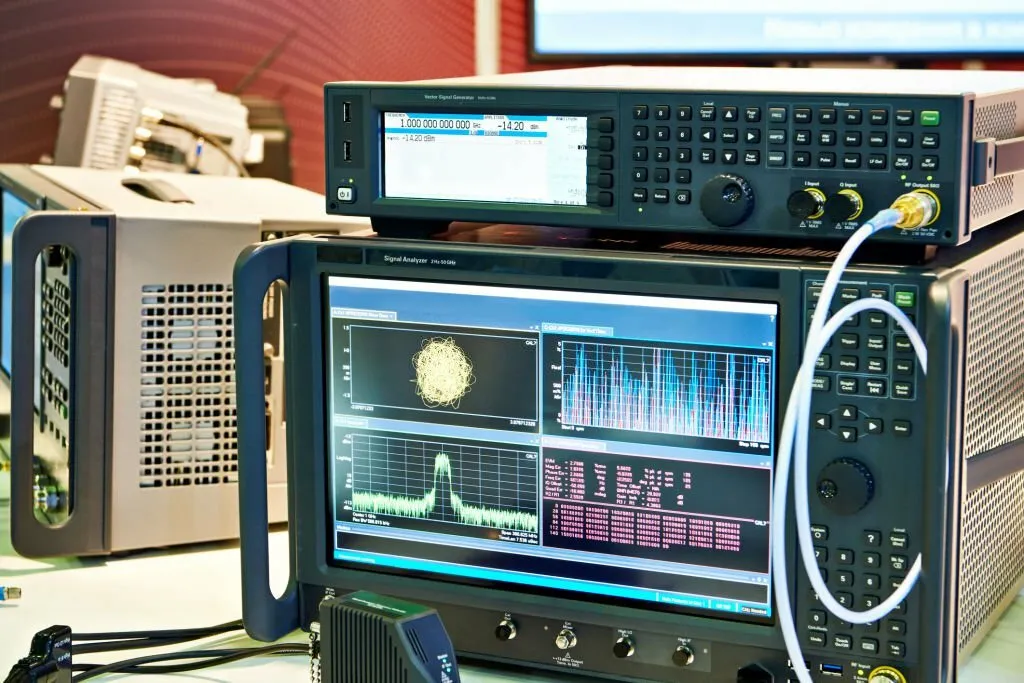
An online oscilloscope or a spectrum analyzer has the ability to examine and display millions of data points. When it comes to helping engineers understand complex electronic signals, these two instruments are invaluable in the field of eonlinelectrical engineering.
Engineers examine the frequency range of electrical signals using spectrum analyzers. To see the time-dependent shape of these signals, they use oscilloscopes. Both tools are essential for designing, testing, and debugging electronic devices, from straightforward circuits to intricate communication networks.
It is essential to comprehend how these two instruments differ from one another. It’s similar to understanding when to use a wrench vs a screwdriver; each has a distinct purpose and use. People often use these terms interchangeably.
This article examines the intricacies of online oscilloscope and spectrum analyzers as well as what makes them different. Let’s dive in!

What is an Oscilloscope?
An online oscilloscope is a tool for visually observing how electrical signals behave. More specifically, it shows the signal’s voltage as a function of time. This time-domain depiction provides a distinctive viewpoint on the transformation and interaction of signals.

Key Features
- Voltage evaluation: Shows a signal’s voltage level over a predetermined amount of time.
- Time interval analysis: Determines the interval between two signal changes, like a rise or drop.
- Frequency Calculation: Determines the frequency at which oscillations occur in a waveform.
- Waveform illustration: A graphical depiction of complex waveforms that facilitates comprehension of their characteristics and actions.
- Phase Connections: examines the difference in phase between various signals, which is necessary to bring systems into synchronization.
Applications
An online oscilloscope is an indispensable instrument in many fields because of their diverse range of applications.
- Troubleshooting: Oscilloscopes detect and diagnose problems in electronic circuits.
- Product Development: Engineers use oscilloscopes for design validation and optimization to ensure that final products satisfy specifications.
- Education & Research: Oscilloscopes aid in education by giving pupils a concrete link between theoretical ideas and notions.
- Analysis of medical equipment: Oscilloscopes can be extremely handy when analyzing and calibrating medical equipment, including ECG machines.
Understanding Spectrum Analyzer
The spectrum analyzer is an indispensable instrument in the field of electrical engineering that enables professionals to view and examine the frequency spectrum of electrical signals.
It sheds light on the various frequency components and the amplitudes that correlate to them through the conversion of the time domain signal into its equivalent frequency domain.

Key Features
- Analyzing frequencies: Identify each frequency component that makes up a complicated signal.
- Amplitude display: Show the different frequency components’ amplitudes.
- Measurement of distortion: Examine the signal for any distortions in harmonics and other irregularities.
- Noise analysis: Recognize and assess both internal and random noise in a signal.
Applications
Spectrum analyzer audio operates in numerous fields and businesses, from the medical industry to telecommunications:
- Telecommunications: They play a significant role in designing, testing, and optimizing communication systems like satellite and cellular networks.
- Audio engineering: In order to produce music and adjust sound systems, spectrum analyzers are essential tools for signal analysis.
- Aerospace engineering: Spectrum analyzers evaluate the reliability of radar and communication systems in aircraft maintenance and design.
- Medical Equipment: Help in testing and calibrating medical equipment such as ultrasound and MRI machines.
Oscilloscope vs Spectrum Analyzer: Main Differences
While there are certain parallels between online oscilloscope and spectrum analyzers, their primary distinctions are in the way they analyze signals, the common uses for which they are put to use, and their technical features. Engineers can select the best tool for their particular requirements by being aware of these differences.
Comparing Time Domain with Frequency Analysis
Spectrum analyzers explore the frequency domain, unraveling signal intricacies by breaking them down into individual frequency components. This is invaluable for tasks like analyzing RF emissions, identifying interference, and tuning RF filters.
On the other hand, oscilloscopes capture signals in the time domain, offering real-time snapshots of voltage variations. They are instrumental in diagnosing timing issues in digital circuits, monitoring pulse shapes in control systems, and verifying analog signal integrity.
Use and Applications
Spectrum analyzers find crucial applications in broadcasting, ensuring signal quality in television or radio broadcasting and analyzing modulation quality in telecommunications networks.
Oscilloscopes play a vital role in automotive engineering by evaluating control signals and communication buses and in industrial automation for monitoring signal integrity and communication protocols.
Technical Details and Efficiency
In terms of resolution, spectrum analyzers offer higher frequency resolution, allowing detailed inspection of narrow frequency bands. They excel in sensitivity, detecting even faint signals within a broad frequency range.
Conversely, however, oscilloscopes shine in time resolution, capturing swift voltage changes and transient phenomena crucial for high-speed digital designs. Their broad bandwidth capabilities enable the representation of rapid signals without distortion, meeting the demands of today’s high-frequency applications.
| Aspect | Spectrum Analyzer | Oscilloscope |
| Bandwidth | Broad, for spectral content analysis | Broad, for high-frequency applications |
| Sensitivity | Detects faint signals precisely | Excellent time resolution for capturing rapid changes |
| Resolution | High-frequency resolution | Excellent time resolution for detailed voltage analysis |
| Preferred Applications | Broadcasting, Telecommunications | Automotive Engineering, Industrial Automation |
| Analysis Type | Frequency Analysis | Time Domain Analysis |
Choosing the Right Tool for Your Needs
While choosing between an oscilloscope and a spectrum analyzer may seem overwhelming, you can make an informed choice if you have the correct advice. Here’s a comprehensive approach to assist you in selecting the ideal tool for your engineering requirements.
Identify Your Requirements
Determining precise tasks and objectives is essential to guarantee the solution meets your demands.
- Identify the Type of Signal: Do you want to investigate time-based features or frequency components?
- Evaluate the Application Area: Do you operate in broadcasting, automotive, industrial automation, or telecommunications?
- Think About Budget Restraints: What are your expenditure caps, and which features are you putting first?
Important Questions to Think About:
- Are you examining any particular type of signals?
- What are the most important parameters that you must follow?
- What industry or discipline is the application in?
- Are certain technologies or characteristics necessary?
Final Thoughts
In conclusion, choosing between an oscilloscope and a spectrum analyzer boils down to understanding your signal analysis needs. Oscilloscopes excel in capturing real-time voltage variations, crucial for digital designs, while spectrum analyzers are vital for in-depth frequency analysis in fields like telecommunications and broadcasting. By identifying your specific requirements, you can confidently select the right tool for your engineering endeavors.
